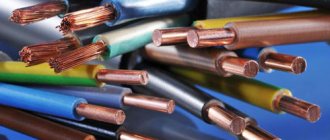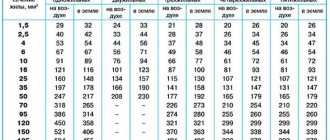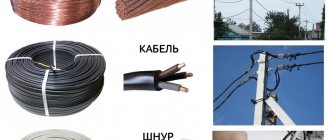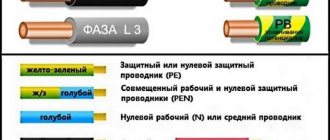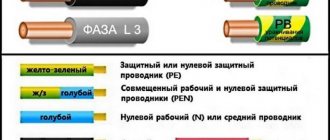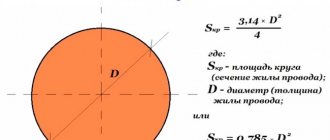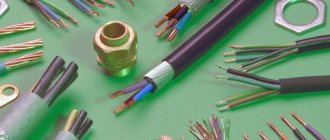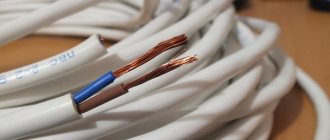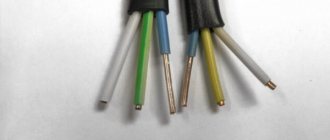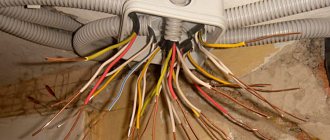Are you planning to modernize the electrical network or extend an additional power line to the kitchen to connect a new electric stove? Here, minimal knowledge about the cross-section of the conductor and the effect of this parameter on power and current will be useful.
Agree that incorrect calculation of the cable cross-section leads to overheating and short circuit or to unjustified costs.
It is very important to carry out calculations at the design stage, since the failure of hidden wiring and subsequent replacement is associated with significant costs. We will help you understand the intricacies of calculations in order to avoid problems in the further operation of electrical networks.
In order not to burden you with complex calculations, we have selected clear formulas and calculation options, presented the information in an accessible form, and provided the formulas with explanations. Thematic photos and video materials have also been added to the article, allowing you to clearly understand the essence of the issue under consideration.
How to find out the cable cross-section by appearance
You can determine the cable cross-section without calculations. A factory-made cable must be marked: on its outer sheath the manufacturer, type of cable, number of cores and cross-sectional area of the current-carrying core are stamped with a certain step.
For example, if the cable has the designation VVG-ng-LS 3x2.5, this means that the cable has an outer sheath and core insulation made of non-flammable PVC with no release of hazardous gases during combustion, and also such a cable has 3 conductive cores with a cross-sectional area each conductor 2.5 mm2.
The marking does not always indicate the true value of the core area, since compliance with this parameter remains on the conscience of the manufacturers. This is due to the fact that most manufacturers do not adhere to GOST during production, but are guided by their own specifications when producing cable products, which leads to a free interpretation of cross-section calculation methods and is not properly regulated. Therefore, before using the cable for its intended purpose, it is best to check that its cross-section corresponds to that stated in the marking.
Segment cable cross-section
When working with conductors, it is necessary to understand their designation. There are wires and cables that differ from each other in their internal structure and technical characteristics. However, many people often confuse these concepts.
A wire is a conductor that has in its design one wire or a group of wires woven together and a thin common insulating layer. A cable is a core or a group of cores that has both its own insulation and a common insulating layer (sheath).
Each type of conductor will have its own methods for determining cross sections, which are almost similar.
The amount of energy that a conductor transmits depends on a number of factors, the main one of which is the material of the current-carrying conductors. The following non-ferrous metals can be used as the core material of wires and cables:
- Aluminum. Cheap and lightweight conductors, which is their advantage. They are characterized by such negative qualities as low electrical conductivity, a tendency to mechanical damage, high transient electrical resistance of oxidized surfaces;
- Copper. The most popular conductors, which have a high cost compared to other options. However, they are characterized by low electrical and transition resistance at the contacts, fairly high elasticity and strength, and ease of soldering and welding;
- Aluminum copper. Cable products with aluminum cores coated with copper. They are characterized by slightly lower electrical conductivity than their copper counterparts. They are also characterized by lightness, average resistance and relative cheapness.
Various types of cables according to core material
Important! Some methods for determining the cross-section of cables and wires will depend specifically on the material of their conductor component, which directly affects the throughput power and current strength (method for determining the cross-section of conductors by power and current)
Aluminum cable with sector conductors
In such cases, it is necessary to resort to a table where the size (height, width) of the cable takes the corresponding value of the cross-sectional area. Initially, it is necessary to measure the height and width of the required segment with a ruler, after which the required parameter can be calculated by correlating the obtained data.
Table for calculating the area of an electric cable core sector
| Cable type | Sectional area of the segment, mm2 | ||||||||
| S | 35 | 50 | 70 | 95 | 120 | 150 | 185 | 240 | |
| Four-core segment | V | – | 7 | 8,2 | 9,6 | 10,8 | 12 | 13,2 | – |
| w | – | 10 | 12 | 14,1 | 16 | 18 | 18 | – | |
| Three-core segmental stranded, 6(10) | V | 6 | 7 | 9 | 10 | 11 | 12 | 13,2 | 15,2 |
| w | 10 | 12 | 14 | 16 | 18 | 20 | 22 | 25 | |
| Three-core segmental single-wire, 6(10) | V | 5,5 | 6,4 | 7,6 | 9 | 10,1 | 11,3 | 12,5 | 14,4 |
| w | 9,2 | 10,5 | 12,5 | 15 | 16,6 | 18,4 | 20,7 | 23,8 |
Choosing a cable
Let's consider a method using the power of devices connected to a given circuit. This option is considered the most accurate. In the technical specifications of the instructions or on the device itself, the manufacturer writes the actual power.
These values need to be summed up and remembered. Further, we assume that the devices will not function simultaneously, so the indicator can be reduced by approximately 15%-25%.
After the calculations, we look in the table for the correct calculation of the wire cross-section for the closest conductor in value with the required core cross-section.
- For example, if after calculating you got 32A, then in the table you will find the most suitable one with a larger side of 38A 4 mm section.
- If we count by power, the algorithm is almost the same: the total amount of device power minus a discount of up to 20%.
- Another way to calculate is to use a formula. For a network with one phase it will look like this: I=P/(U*cosPhi)
For a 3-phase network:
- P—device power;
- U – voltage;
- cos Phi - power indicator 1.4142 for 2 phases, 1.732 - in relation to 3 phases;
- I – current consumption.
Further selection of the core cross-section is similar.
- If you choose a suitable material for the length, you should take into account that the resistance inside the cable reaches high values.
- This threatens the maximum reduction in voltage on the remote part of the network with high power consumption.
- As a result, the necessary tool does not show the required power, and household devices operate in abnormal mode.
The length of the conductor has a significant effect on voltage reduction. In everyday life, these disadvantages can be ignored; it is recommended to simply take the material 15-20 cm longer, this stock will be enough for connection. If it is connected to a shield, then you need to take a longer piece; they will be required for automatic protection.
When installing over long distances, the possibility of voltage drop is taken into account, because any cable provides electrical resistance, and this can be affected by:
- The meter of the conductor, with its longer length, losses increase;
- The quadrature of the cross section, when it increases, the voltage drops;
- The resistance of the reference sample indicates the conductor size sq.mm*m.
It is assumed that the permissible drop value is no more than five percent, otherwise the cable is chosen incorrectly and will have to be changed.
How to determine whether the parameters match?
As a rule, extreme care on your part allows you to avoid such incidents during the purchase:
- A normal wire must have its marking, which provides the buyer with all the information about the model, operating features, and parameters. If you encounter questionable products, you may find that the product data is not presented in full or is completely missing.
- If the conductor is really good, he must be provided with quality certificates. The technical documentation indicates that it was not only manufactured in accordance with the ND, but also passed the appropriate tests.
- A good wire cannot cost a penny - since the price of materials is quite high, the cheapness should make you wonder if there is some kind of catch in this. If you wish, you can come to the store with a micrometer or caliper and perform a test to clear your doubts.
Determination of cross-section by diameter
After determining the diameter of the wire, you can begin to calculate the cross-sectional area in squares (mm2). For cables of the VVG type, consisting of three single-core conductors, calculation methods are used using a formula or a ready-made table of diameters and areas. The methods are also applicable to products with other markings.
According to the formula
The main method is to calculate using a formula of the form - S=(n/4)*D2, where π=3.14, and D is the measured diameter. For example, to calculate the area with a diameter of 1 mm, you will need to calculate the value: S=(3.14/4)*1²=0.785 mm2.
Online calculators are available on the Internet that allow you to calculate the area of a circle by diameter. Before purchasing a cable, it is recommended to calculate the values in advance, put them in a table and use it in the store.
The video from user Alexander Kvasha demonstrates checking the cross-section of wire cores.
According to the table with common diameters
To simplify the calculation, it is convenient to use a ready-made table.
The order of using numbers from the table:
- Select the type of wire that you intend to purchase, for example, VVG 3*4.
- Determine the diameter from the table - a section of 4 mm2 corresponds to a diameter of 2.26 mm.
- Check the actual wire diameter. If there is a match, the products can be purchased.
Below is a table of the ratio of cross-sections of the main types of copper wiring to diameters and current (at a voltage of 220 V).
| Wire core diameter, mm | Core cross-section, mm2 | Allowable current, A |
| 1,12 | 1 | 14 |
| 1,38 | 1,5 | 15 |
| 1,59 | 2,0 | 19 |
| 1,78 | 2,5 | 21 |
| 2,26 | 4,0 | 27 |
| 2,76 | 6,0 | 34 |
| 3,57 | 10,0 | 50 |
| 4,51 | 16,0 | 80 |
| 5,64 | 25,0 | 100 |
| 6,68 | 35,0 | 135 |
An additional criterion for matching the cross-section to the diameter is the weight of the wire. The method of determining diameter by weight is used when testing thin wire for winding transformers. The thickness of the product starts from 0.1 mm, and it is difficult to measure it with a micrometer.
A brief table of correspondence between vein diameters and weight is given below. Detailed data is available in stores specializing in the sale of electronic components.
| Diameter, mm | Section, mm2 | Weight, g/km |
| 0,1 | 0,0079 | 70 |
| 0,15 | 0,0177 | 158 |
| 0,2 | 0,0314 | 281 |
| 0,25 | 0,0491 | 438 |
| 0,3 | 0,0707 | 631 |
| 0,35 | 0,0962 | 859 |
| 0,4 | 0,1257 | 1,122 |
When calculating the wire diameter for fuses, the conductor material should be taken into account. A brief table of cable diameters from common types of material and current strength is given below.
| Break current, A | Copper | Aluminum | Nikelin | Iron | Tin | Lead |
| 0,5 | 0,03 | 0,04 | 0,05 | 0,06 | 0,11 | 0,13 |
| 1 | 0,05 | 0,07 | 0,08 | 0,12 | 0,18 | 0,21 |
| 5 | 0,16 | 0,19 | 0,25 | 0,35 | 0,53 | 0,60 |
| 10 | 0,25 | 0,31 | 0,39 | 0,55 | 0,85 | 0,95 |
| 15 | 0,32 | 0,40 | 0,52 | 0,72 | 1,12 | 1,25 |
| 25 | 0,46 | 0,56 | 0,73 | 1,00 | 1,56 | 1,75 |
| 50 | 0,73 | 0,89 | 1,15 | 1,60 | 2,45 | 2,78 |
| 100 | 1,15 | 1,42 | 1,82 | 2,55 | 3,90 | 4,40 |
| 200 | 1,84 | 2,25 | 2,89 | 4,05 | 6,20 | 7,00 |
| 300 | 2,40 | 2,95 | 3,78 | 5,30 | 8,20 | 9,20 |
For multi-core cable
The diameter of a multi-core cable is determined by the cross-sectional size of one conductor multiplied by their number. The main problem is measuring the diameter of a thin wire.
An example is a cable consisting of 25 cores with a diameter of 0.2 mm. According to the above formula, the cross-section is equal to: S=(3.14/4)*0.2²=0.0314 mm2. With 25 cores it will be: S=0.0314*25=0.8 mm2. Then, using the correspondence tables, it is determined whether it is suitable for transmitting the current of the required strength or not.
Another way to approximately calculate the current strength is to multiply the diameter of a multi-core cable by an adjustment factor of 0.91. The coefficient provides for a non-monolithic wire structure and air gaps between the turns. The outer diameter is measured with little effort, since the surface is easily deformed and the cross-section becomes oval.
When calculating the segment part of the cable, formulas or table values are used. The table shows the standard values for segment width and height.
| Sectional area, mm2 | 35 | 50 | 70 | 95 | 120 | 160 | 185 | 240 |
| Height/width for three-core monolithic cable, mm | 5,5/9,2 | 6,4/10,5 | 7,6/12,5 | 9/15 | 10,1/16,6 | 11,3/18,4 | 12,5/20,7 | 14,4/23,8 |
| Height/width for three-core cable made of thin cores, mm | 6/10 | 7/12 | 9/14 | 10/16 | 11/18 | 12/20 | 13,2/22 | 15,2/25 |
| Height/width for four-core monolithic cable, mm | No | 7/10 | 8,2/12 | 9,6/14,1 | 10,8/16 | 12/18 | 13,2/18 | No |
Section calculation
If there is a cable in front of you, the cross-section of which you do not know (there is no marking), then this indicator can be calculated independently using the formula for the area of a circle:
S=πd²/4=0.8d².
That is, you measure the diameter of the core with your own hands using a caliper and insert this indicator into the formula. If the marking on the wire remains, for example, VVG 3x1.5, then this means that you have a three-core wire with a cross-section of 1.5 mm².
But it is also necessary to take into account the fact that wires are different in terms of the material from which they are made. All electrical cables are based on either copper or aluminum. So, copper cables can withstand a higher current load than aluminum cables. In addition, they practically do not oxidize, so when you are faced with a choice, it is best to give preference to the copper option.
There is one more point that needs to be taken into account. This is the method of wiring a power supply circuit. That is, the electrical cable was laid in grooves and plastered, or the wiring was carried out in a corrugated hose, or open electrical wiring was made. What is the difference?
The thing is that internal wiring (hidden) creates conditions under which the wire ends up in a confined space. That is, when heated, it does not give off heat to the air that surrounds it. This means it overheats faster and more. And this, in turn, reduces the service life and creates conditions for rapid failure. That is, in such wiring it is necessary to use wires with a cross-section slightly larger than the nominal one.
Current Density
Gradually, understanding electrical wires, or more precisely, the choice of cable cross-section, we came to another equally important indicator - current density. What it is? Essentially, this is the same current strength, measured in amperes, that passes through a standard cross-section of an electrical wire equal to one millimeter squared
Let's just say that this is a relative value, so it can be used in the formula that determines the diameter of the wire:
d=1.1*√I/Ip, where Ip is the current density.
Now you can calculate the cross-section of the wire by substituting the value of “d” into the area formula. Ultimately we get that S=I/Ip.
But where then can I get the “Ip” readings? These are standard values, depending again on the material from which the wires are made and the type of wiring. The table below shows this relationship.
Area of a circle
| Material | Copper | Aluminum |
| Hidden wiring | 6 A/mm² | 4 |
| Open wiring | 10 | 6 |
As we said above, copper is preferable in this case.
Let's look at one simple calculation example. Input data:
- The wire is copper.
- Open wiring.
- Cable load 2.2 kW.
First, we find the current strength in the electrical circuit: I=P/U=2200 W:220 V= 10 A.
Now we find the cross-section of the wire itself: S=I/Ip=10:10=1 mm², where the second number “10” is selected from the above table. Thus, you can independently calculate all cable cross-sections in each section of the electrical network at home. The main thing is to correctly calculate the power consumption on each loop. And this, as you know, is the total power of all household appliances and lighting bulbs. For example, if you are calculating a kitchen area, you will have to add up the power of all devices, and this is a refrigerator, microwave, coffee maker, electric kettle, hood, blender, and so on, plus lighting. This indicator is indicated on instrument tags and glass lamp housings.
In principle, you can assemble such a table of wire cross-sections for yourself, taking into account all the layouts described above. That is, if you know the power consumption on all electrical circuits, then you can divide the cables into sections depending on their cross-section.
Power of some household electrical appliances
- Firstly, it will simplify installation. That is, you will never get confused where which cable should be laid.
- Secondly, it will be possible to calculate the costs associated with the purchase of wiring, and thereby determine the repair budget.
- Thirdly, the table will help in the future. If the power consumption does not change over the years, then you will not need to do all the calculations again. It is enough to get a table and remember what cross-section the cable is and where it was laid.
Voltage drop calculation
In any conductors, over a long cable line, the voltage drops because they have inherent resistance.
According to the standards of the Rules for the Operation of Electrical Installations (Table 7), the cross-sectional area of the conductors must allow a voltage loss of up to 5%. This is especially true for lines with a small cross-section.
Table 7.
Formulas used to determine voltage loss:
R=2*(p*L)/S,
Upad=I*R,
U%=(Up/Ulin)*100,
Where:
2 - coefficient of two-wire electrical wiring, since current flows through 2 wires simultaneously;
R - resistance in Ohms;
p—conductor resistivity, Ohm*mm2/m;
S—sectional area, mm2;
Upad—voltage drop, V;
U% - voltage drop relative to line voltage in %.
Example. Single-phase copper wire 20 m long with a cross-section of 1.5 mm2. We connect the device, it consumes 7 kW of electricity.
If the current is insufficient, it is recommended to connect different devices to different branches of the electrical wiring.
We will calculate the voltage drop in the following sequence.
- Let's determine the resistance of the copper cable according to Table 9.
R=2×(0.0175×20m)/1.5=47 Ohm.
- Let's find the current strength that will pass through the conductor.
I=7000/220=31.8 A.
- Let's determine the voltage drop.
Upad=31.8×0.47=14.95 V.
- We are looking for the percentage of voltage drop.
U%=(14.95/220)×100=6.8%.
Based on the calculation results, the conclusion suggests itself that this cable will be insufficient for the welding machine. To avoid electrical failures, it is necessary to use wiring with a larger cross-sectional area.
Different ways: how to determine the wire cross-section
A conductor is often referred to by two different words – wire and cable. This mixture is very inconvenient. In everyday life, these concepts are often confused, although there are some significant differences in the operation of these devices. In order to correctly determine and correctly find out the cross-sectional area, it is necessary to understand the differences between these conductors and understand a more or less accurate definition.
A conductor consists of a group of cores that are enclosed in separate insulation or in common insulation. The cores come in different types, usually woven or solid, depending on the wire model. Their diameter is measured both with a regular ruler and with a special device - a caliper. As a rule, conductors are made of various non-ferrous metals.
Typically the materials are as follows:
- Copper;
- Aluminum;
- Aluminum copper – (this is an alloy of aluminum and copper specially developed by scientists).
All these materials are distinguished by a relatively low price, low electrical resistance, fairly high electrical conductivity, ease of welding and installation
Another important characteristic is the minimal weight of the metal wire. The methods for finding the cross-sectional area of the above conductors are almost the same, and measuring it is not difficult at all
How to determine
There are several ways to determine this value of an electrical wire. There are formulas that can be used to calculate a parameter or tables that contain all the values of common standard conductors. Knowing one parameter, for example, the diameter of the core, its current-carrying capacity, you can also find out the cross-section. Other methods of determination are:
- according to the formula through the diameter - S=π*R², where R is ½ the diameter (d), and π=3.14;
- measuring instrument - micrometer;
- using a caliper;
- when using a pencil or pen;
- ruler based on diameter.
A micrometer, as well as a caliper, helps to determine the most accurate diameter, and then, based on it, calculate the cross-section using the formula: S= d*d*d/4, the result will be in mm². Using tools, conductive elements of a circular cross-section are measured, but they are quite expensive and therefore it is not practical to buy them for one time.
To determine using a pen or pencil (a marker, felt-tip pen, etc. are suitable), first cut off the insulation. Then the core is tightly wound around the writing instrument along its entire length. Then measure the length of the winding with a ruler and divide it by the number of turns to find out the diameter. The more turns are made, the more accurate the calculation. When the diameter has become known, the cross-section is calculated using a special formula.
You can calculate this parameter using only a ruler, but the core must be thick enough. The diameter is determined with thread or thin paper - for greater accuracy. A strip is torn from the sheet and folded on one side. The paper is then wrapped around the core until it touches the strip. At the joint, bend it again and apply it to a ruler for measurement. The same applies to thread. The diameter is calculated using the formula: d=l/2π, where l is the length of the paper or thread. Then they use the standard calculation - S=π*R² to determine R, d (diameter) divided by 2.
Conditions for working with a table of cable cross-sections by diameter
The cable cross-section tables differ in some characteristics from the wire data, but the main characteristics and concepts are still the same - diameter and area. The calculation and its principle are not particularly different. In addition, the cable cross-section table invariably contains the following characteristics, for example, power, current, resistance of a particular material (copper or aluminum).
It should also be remembered that over time, the load can increase significantly for various reasons independent (including) from the owner of the apartment. In order not to create a fire hazard in your own apartment, it is advisable to select wires together with a qualified installation specialist, and to install these wires/cables and connections together with them.
Of course, the data provided in this table is adequate to reality only if certain conditions are met:
- The air temperature is slightly less than or equal to, for example, +30 ᵒC (it is clear that the temperature is different for each table, usually additional conditions are specified).
- The network voltage is 220 V.
- The wire is three-core, with general insulation.
- Separate grounding.
- Laying in a closed space - in the air or in a box.
There are also other conditions that it is advisable not to neglect in order to avoid dangerous and difficult situations associated with equipment failure or a threat to the safety (life and health) of people.
Features of electrical wires
The most widely used brands of wires are PUNP and PUGNP, as well as VPP, PHCB and PKGM, which have the following basic technical characteristics that are very important for obtaining a safe connection:
- PUNP is a flat wire product of the installation or so-called installation type, with single-wire copper conductors in PVC insulation. This type is distinguished by the number of cores, as well as a rated voltage within 250 V with a frequency of 50 Hz and an operating temperature from minus 15 °C to plus 50 °C;
- PUGNP is a flexible type with multi-wire conductors. The main indicators, which are represented by the nominal voltage level, frequency and temperature operating conditions, do not differ from similar data from PUNP;
- APB is an aluminum single-core variety, a round wire with protective PVC insulation and a single-wire or multi-wire core. The difference between this type is its resistance to mechanical damage, vibration and chemical compounds. The operating temperature ranges from minus 50 °C to plus 70 °C;
- PBC is a stranded copper variety with PBX insulation, which gives the wire high density and a traditional round shape. The heat-resistant core is designed for a nominal level of 380 V at a frequency of 50 Hz;
- PKGM is a power mounting type, represented by a single-core copper wire with silicone rubber or fiberglass insulation impregnated with a heat-resistant compound. The operating temperature ranges from minus 60 °C to plus 180 °C;
- PHCB is a single-core heating type in the form of a single-wire wire based on galvanized or blued steel. Operating temperature ranges from minus 50 °C to plus 80 °C;
- The runway is a single-core copper variety with a stranded core and PBX or polyethylene insulation. The operating temperature ranges from minus 40 °C to plus 80 °C.
In conditions of low power, copper wire ШВП with protective external PBX insulation is used. The stranded core has excellent flexibility, and the wire product itself is designed for a maximum of 380 V, with a frequency within 50 Hz.
Wire products of the most common types are sold in coils, and most often have white insulation.
Determining the size of the cable cross-section
Cables can be either single-core or multi-core. In the second case, it is best to determine the diameter of each individual core. Also, the core can be single-wire or consist of many wires. Regardless of the type of cable, you can determine its cross-section by diameter.
However, do not forget that “it’s also written on the fence” and it is best to carry out all the necessary measurements yourself when choosing a wire. Fortunately, carrying them out is not that difficult. Determining the actual wire diameter is possible using available tools. Such tools include a micrometer and a caliper.
Micrometer measurement
The most accurate method for measuring diameter is using a micrometer. For such a measurement, you need to take a conductor and move the measuring screw to it until the characteristic ratcheting sound appears. The exact diameter value consists of two values: on the micrometer rod and on the drum.
Measuring with a caliper
You can also measure the cable diameter using a common tool such as a caliper. To do this, you need to clamp the wire to be measured between the jaws of the meter and read the exact value from a special scale.
Measuring with a ruler
The least accurate type of measurement is using a simple ruler. However, in this case, accuracy can be achieved by measuring a large number of turns. The procedure for measuring with a ruler:
- A conductor is wound around a certain rod over a certain distance.
- The length of the wrapped section of the rod is measured with a ruler.
- The resulting value is divided by the number of turns.
This method still has a certain accuracy due to the reduction in error.
Next, you can determine the cable cross-section by diameter. This can be done using the formula:
S = π*D2/4
where D is the measured diameter of the wire.
On this topic:
BACK FORWARD 1 of 2
The skill of independently calculating the conductor cross-section will help you avoid all sorts of problems in the future, as well as deception on the part of the product supplier.
Tables and norms
Another very common method for determining the wire cross-section by diameter is the use of standardized tables that list all the most common and widely used cable cross-sections.
The procedure for selecting the wire cross-section according to the table:
- First you need to decide on the type of cable.
- Next, we find the diameter we need in the table.
- We determine the appropriate section.
- If necessary, we independently check the indicators using the methods described above and make a decision on purchase.
Table of wire cross-sections by diameter.
| Wire core diameter, mm | Core cross-section, mm2 |
| 1,12 | 1 |
| 1,38 | 1,5 |
| 1,59 | 2,0 |
| 1,78 | 2,5 |
| 2,26 | 4,0 |
| 2,76 | 6,0 |
| 3,57 | 10,0 |
| 4,51 | 16,0 |
| 5,64 | 25,0 |
| 6,68 | 35,0 |
The table relating wire cross-section and diameter shows that the formula described above is very fair. The cross-section values given in the proposed table are calculated precisely from it with certain permissible roundings.
So, we already know how to independently find out the wire cross-section. All that remains is to put the acquired knowledge to good use.
When purchasing a cable, you can ask the seller to strip a small section of the wire in order to carry out all the necessary manipulations to measure the product. However, practice shows that not many sellers take such a step. Then the only solution is to first purchase a small section of cable needed for measurements. But after all doubts have disappeared, you can purchase as much wire as you need. Still, the not most joyful fact is that truly attentive buyers often choose a cable with a larger cross-section. After all, in reality they turn out to be somewhat smaller than the formal sizes.
Wire diameter measurement
According to the standard, the diameter of the wire must correspond to the declared parameters, which are described in the marking. But the actual size may differ from the declared one by 10-15 percent. This is especially true for cables that are manufactured by small companies, but large manufacturers can also have problems. Before purchasing an electrical wire for transmitting large currents, it is recommended to measure the diameter of the conductor. For this purpose, various methods can be used, differing in error. Before performing measurements, it is necessary to remove insulation from the cable cores.
Measurements can be made directly in the store if the seller allows you to remove the insulation from a small section of the wire. Otherwise, you will have to purchase a small piece of cable and take measurements on it.
Micrometer
Maximum accuracy can be achieved using micrometers that have a mechanical and electronic circuit. On the shaft of the instrument there is a scale with a division value of 0.5 mm, and on the circle of the drum there are 50 marks with a division value of 0.01 mm. The characteristics are the same for all micrometer models.
When working with a mechanical device, the following sequence of actions should be followed:
- By rotating the drum, the gap between the screw and the heel is set close to the measured size.
- Use a ratchet to bring the screw closer to the surface of the part being measured. The eyeliner is performed by rotating the hand without effort until the ratchet operates.
- Calculate the transverse diameter of the part according to the readings on the scales located on the stem and drum. The diameter of the product is equal to the sum of the values on the rod and the drum.
Mechanical micrometer measurement
Working with an electronic micrometer does not require rotation of the units; it displays the diameter value on the liquid crystal screen. It is recommended to check the settings before using the device as electronic devices measure in millimeters and inches.
Vernier caliper
The device has reduced accuracy compared to a micrometer, which is quite sufficient for measuring a conductor. Vernier calipers are equipped with a flat scale (vernier), a circular dial or a digital display on a liquid crystal display.
To measure the transverse diameter, you must:
- Clamp the conductor to be measured between the jaws of the caliper.
- Calculate the value on the scale or view it on the display.
An example of calculating size on a vernier
Ruler
Measuring with a ruler gives a rough result. To perform measurements, it is recommended to use tool rulers, which have greater accuracy. Using wooden and plastic school products will give a very approximate diameter value.
To measure with a ruler you need:
- Remove insulation from a piece of wire up to 100 mm long.
- Wind the resulting piece tightly around a cylindrical object. The turns must be complete, that is, the beginning and end of the wire in the winding are directed in one direction.
- Measure the length of the resulting winding and divide by the number of turns.
Measuring the diameter with a ruler by the number of turns
In the example above there are 11 turns of wire which are about 7.5mm in length. By dividing the length by the number of turns, you can determine the approximate value of the diameter, which in this case is 0.68 mm.
On the websites of stores selling electrical wires, there are online calculators that allow you to calculate the cross-section based on the number of turns and the length of the resulting spiral.
Formula: how to determine cable cross-section
The concept of cross-sectional area, or, in common parlance, cable thickness is an interesting thing. It is determined by a device called a caliper. First, using this device, you need to calculate the diameter of the conductor (of course, previously cleared of insulation).
Then you should find the cable area using the formula S = π (D/2)2, in this formula:
- S is the cross-sectional area of a stranded or solid conductor, which is expressed in mm2.
- π = 3.14 (the banal, well-known number Pi).
- D is the diameter of the electrically conductive cable core, expressed in mm.
Conversion to other units of measurement or to the SI system is optional. You can also write this formula in abbreviated form: S = 0.8 D² (the area is equal to the product of 0.8 and the square of the diameter). In this case, 0.8 D² is a rounded factor. In fact, calculating the cross-sectional area and the ratio of different parameters of the conductor is not at all difficult.
By the way, it is very convenient to measure the cross-sectional area with a micrometer or use a calculator.
Of course, it will not give an exact number, like 16mm2, but it will make the calculations much easier. Watching a video about this is quite boring, but it can be quite useful, especially if you decide to do home renovations yourself (this is not a very good idea, but your apartment is your rules).
Conductor cross-sectional area
Neva MT-324
In drawings, a wire section is an image of a figure formed by cutting a part with a plane. What is a cross section in electrical engineering? Applicable to electricity, considers the cross-section of a conductor at right angles to its longitudinal side. The cross-section of the core through which electrons pass is a circle and is measured in mm2.
Important! The diameter of the core is often confused with its cross-section. To find out what cross-section the wire has, you need to determine the area of the resulting circle by calculating it using the formula.
Conductor cross section
Since the cross-section of the wire is a circle, the area is calculated using the formula:
S cr = π*R2, where:
- S cr. – area of the circle, mm2;
- π = 3.14;
- R – radius of the circle, mm.
Knowing the cross-sectional area of the core, its length and the resistivity of the material from which it is made, it is possible to calculate the resistance of the conductor to the electric current flowing through it.
Information. Considering that the radius is equal to 1/2 the diameter, the formula can be transformed for ease of use. It will look like Skr = π*D2/4 = 0.8 * D2. To calculate the cross-sectional area of a conductor, the diameter value is often used.
An incorrectly selected wire diameter causes it to overheat and melt, which, in turn, can cause a fire in the electrical wiring.
How to calculate the cross-section of a copper wire and determine the load on the cable
| Max. power, kWt | Max. load current, A | Wire cross-section, mm2 | Circuit breaker current, A |
| 4.5 | 4-6 | ||
| 9.1 | 1.5 | ||
| 13.6 | 2.5 | ||
| 18.2 | 2.5 | ||
| 22.7 | |||
| 27.3 | |||
| 31.8 | |||
| 36.4 | |||
| 40.9 | |||
| 45.5 | |||
| 50.0 | |||
| 54.5 | |||
| 59.1 | |||
| 63.6 | |||
| 68.2 | |||
| 72.7 | |||
| 77.3 |
This table shows the data for the following case.
— Single phase, voltage 220 V
— Ambient temperature 30 C
— Laying in the air or in a box (in a closed space)
— Three-core wire, in general insulation (cable)
— The most common TN-S system with a separate ground wire is used
— The consumer reaching maximum power is an extreme but possible case. In this case, the maximum current can operate for a long time without negative consequences.
If the ambient temperature is at least 20 C higher, or if there are several cables in the bundle, it is recommended to select a larger cross-section.
It is also important to know what kind of wire you are buying. Some manufacturers underestimate the cross-section of the cable cores to save money and time
There are a number of companies making such wires (I will not list them).
But there are also those who make high-quality, but expensive wires
This is worth paying maximum attention to
In the process of determining the cross-section of the wire by diameter, it is necessary to pay attention to the metal of the core. Copper or aluminum conductor is characterized by a bright, rich color
If the color is in doubt, then we can conclude that the quality is low. Most likely, the manufacturer simply saved on metal by using a metal alloy for manufacturing.
The alloy is dangerous for installation work, because the rated load and current conductivity are lower compared to the original product.
- To accurately determine the cross-sections of the wires, look at the cores. With normal thickness of products, a situation is possible where a decrease in the size of the core is compensated by an increase in the insulation layer.
- Experts advise purchasing a wire with a larger cross-section. It is worth considering that the power reserve cannot damage the quality and performance of the electrical wiring.
- The calculation changes if we are talking about a cable, since it consists of several wires. To obtain the most accurate indicators, you need to determine the diameter of each wire, then sum the resulting values.
There are different ways to determine the cross-section of a wire by diameter. Experienced electricians can determine this value in a matter of minutes. Beginners are advised to choose the method that is closest and clearest to you.
Why learn to do calculations?
First of all, the implementation of such mathematical operations is required to ensure the safety of the premises. Any cable or wire is the main means for transmitting and distributing current to electrical devices.
Almost every day, an electrician needs to connect an electric kitchen stove somewhere, fix an outlet, or install a new lamp. In a word, the need to calculate the wire cross-section is due to ensuring a constant flow of electricity and avoiding various unpleasant situations, which include some damage to the electrical wiring itself.
If you connect the device via a cable and the cross-section of the selected wires is small, unable to ensure the normal functioning of the device in the required volumes, then the cable itself will overheat, which, in turn, leads to slow destruction of the insulation. As a consequence of a possible short circuit. As a result of a decrease in the reliability and service life of the electrical wiring in the room, the operation of the electrical wiring in the room will sharply drop or, moreover, disappear, that is, burn out.
The most common everyday situation today is an attempt to save on the cost of wires, which inevitably leads to short circuits or fires.
It is for this reason that before carrying out the electrical wiring of the cable, it is necessary to determine the cross-section of the wires used throughout the apartment:
- the number of household appliances that will be in the apartment;
- total power and consumed load of devices, taking into account a small margin;
- carry out mathematical calculations;
- determine the type and cross-section of the required wires.
Device recommendations
The wiring device, among other things, requires design skills, which not everyone who wants to do it has. It is not enough to just have good electrical installation skills. Some people confuse design with drawing up documentation according to some rules. These are completely different things. A good project can be written out on pieces of paper from a notebook.
First of all, draw a plan of your premises and mark future sockets and lamps. Find out the power of all your consumers: irons, lamps, heating devices, etc. Then enter the power of the loads most frequently consumed in different rooms. This will allow you to choose the best cable options.
You will be surprised how many opportunities there are and what reserves there are for saving money. Once you have selected your wires, count the length of each line you draw. Put everything together, and then you will get exactly what you need, and as much as you need.
Each line must be protected by its own circuit breaker (circuit breaker), designed for a current corresponding to the permissible power of the line (the sum of the consumer powers). Label the machines located in the panel, for example: “kitchen”, “living room”, etc.
It is advisable to have a separate line for all lighting, then you can easily repair the socket in the evening without using matches. It is the sockets that are most often overloaded. Provide outlets with enough power - you don't know in advance what you'll have to plug into them.
In damp rooms, use only double-insulated cables! Use modern sockets (“Euro”) and cables with grounding conductors and connect the grounding correctly. Bend single-core wires, especially copper ones, smoothly, leaving a radius of several centimeters. This will prevent them from breaking. In cable trays and channels, the wires should lie straight, but freely; in no case should they be pulled like a string.
There should be a few extra centimeters in sockets and switches. When laying, you need to make sure that there are no sharp corners anywhere that could cut the insulation. It is necessary to tighten the terminals tightly when connecting, and for stranded wires this procedure should be repeated; they have a tendency for the cores to shrink, as a result of which the connection may become loose.
Copper wires and aluminum wires are not “friendly” with each other for electrochemical reasons; they cannot be connected directly. To do this, you can use special terminal blocks or galvanized washers. The joints must always be dry.
Phase conductors should be white (or brown), and neutrals should always be blue. Grounding is yellow-green in color. These are generally accepted color rules and commercial cables, as a rule, have internal insulation in exactly these colors. Compliance with colors increases the safety of operation and repair.
We bring to your attention an interesting and educational video on how to correctly calculate the cable cross-section by power and length:
The choice of wire cross-section is the main element of a power supply project of any scale, from a room to large networks. The current that can be taken into the load and power will depend on this. Choosing the right wires also ensures electrical and fire safety and keeps your project budget-friendly.
Often, before purchasing cable products, there is a need to independently measure its cross-section in order to avoid deception on the part of manufacturers, who, due to savings and setting a competitive price, may slightly underestimate this parameter.
Variety of cable products and wires
It is also necessary to know how the cable cross-section is determined, for example, when adding a new energy-consuming point in rooms with old electrical wiring that does not have any technical information. Accordingly, the question of how to find out the cross-section of conductors always remains relevant.
Table of wire sections and diameters
Sometimes, instead of fiddling with wires with a ruler, it is much easier to use ready-made tables. One of them will be given below with some abbreviation. In such a table, the left column will indicate the specific diameter of the wire strands, and the right column will indicate the cross-section of the conductor in square millimeters.
Section definition:
- 0.8 mm2 – 0.5;
- 1 mm2 – 0.75;
- 1.1 mm2 – 1;
- 2.28 mm2 – 6;
- 3.2 mm2 – 8;
- 4 mm2 – 8.3.
The table above is far from complete. In total there are about 10-12 lines in it, and each of its meanings can easily be found in a store. The most accurate information on each specific type of wires and cables will be provided upon request by a sales consultant in a household appliances or electrical goods store.
The following characteristics may also be useful. For example, the table may also indicate whether the wire is laid open, how many wires are in one connection and what exactly they are, for example, 2, 3, 4 single-core or 1 two-wire, 1 three-wire.
These points are also very important, which is why, when planning to install a wire and calculate its cross-sectional area, such details should still be clarified and measured for the sake of peace of mind and comfort. An error threatens the failure of all electronics (TVs, desktop computers, refrigerators, electricity and even washing machines), as well as a fire hazard in your own home. That is why, when choosing any wires or cables at home, a thrifty owner must be an extremely attentive, demanding and careful buyer.
Wire cross-section in old buildings and maximum load
In Soviet-era high-rise buildings, aluminum wiring is used. Taking into account the correct connection of the nodes in the junction box, the quality of the insulation and the reliability of the connection contacts, it will last from 10 to 30 years.
If it is necessary to connect equipment with high energy consumption in houses with aluminum wiring, the cross-section and diameter of the cores are selected based on the power consumption. All data is shown in the table.
| Current, A | Maximum power, VA | Cable diameter, mm | Cable cross-section, mm2 |
| 14 | 3000 | 1,6 | 2 |
| 16 | 3500 | 1,8 | 2,5 |
| 18 | 4000 | 2 | 3 |
| 21 | 4600 | 2,3 | 4 |
| 24 | 5300 | 2,5 | 5 |
| 26 | 5700 | 2,7 | 6 |
| 31 | 6800 | 3,2 | 8 |
| 38 | 8400 | 3,6 | 10 |
Section according to GOST or TU
A large assortment of electrical products helps to quickly solve problems associated with electrical installation work. The quality of these products plays a very important role and all products must comply with GOST requirements.
Often, manufacturers, wanting to save money, find loopholes to deviate from GOST requirements and themselves develop technical production conditions (TU) taking into account the permitted errors.
As a result, the market is oversaturated with low-quality and cheap goods that need to be double-checked before purchasing.
If the cables available in retail outlets of a suitable price do not correspond to the declared characteristics, the only thing that can be done is to purchase a wire with a reserve cross-section. Power reserve will never negatively affect the quality of electrical wiring
It would also be useful to pay attention to products from manufacturers who value their name - although they are more expensive, they are a guarantee of quality, and wiring replacement is not done so often that you can save on it
